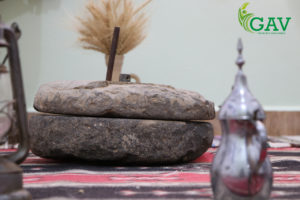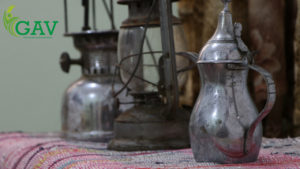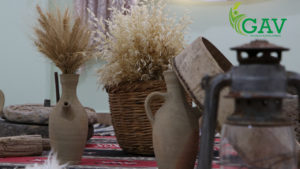A room collecting the heritage symbols and tools of the Jazira region
The volunteers of the Bayt al-Jazira project collected a lot of traditional tools to decorate the activities room which will witness many joint activities during the next two months.
In cooperation with the project coordinators, the team of the volunteers consisting of 10 people of the Kurds, Arabs, Syriacs and Yazidis, were able to collect these tools after research and visits to many areas of the Jazira region.
For example, the list of the traditional tools includes the millstone, which is called Destar in Kurdish, in Syriac Rehyo–ܪܚܝܐ, and in Arabic Raha.
This tool is considered one of the most popular traditional pieces, as it was used to grind grain by hand, and it often required the cooperation of two people mainly to obtain bulgur in addition to other foodstuffs or feedstuffs.
This millstone consists of two circular stones, where a wood called Destik, (handle in English) is installed on the upper section of the stone to facilitate the process of movement and rotation, while the lower section remains stable.
This heritage tool is still spread in most villages, but its use has decreased dramatically with the emergence of modern machinery used to grind grain. However, it is now used in the production of small quantities of feedstuffs.
Near the millstone, you see another piece which is called al-Jern wel Middaq in Arabic and in Kurdish Jouni u Mikut, (in English Grin and Pestle). Its function is not much different from the previous millstone.
This tool emerged hundreds of years ago with the spread of the cultivation of grains in the Jazira region, as it was an ideal tool for preparing different types of grains used in preparing some popular foods such as Mehir in Kurdish and Habiyah in Arabic, a kind of traditional dish in the region consisted of wheat and cold yoghurt.
This tool consists of two parts, the first is a bowl or a concave stone ball, while the other is a light wooden hammer to avoid excessive grinding of the grains.
All these heritage tools in addition to the folkloric costumes and symbols collected in the activities room of the Bayt al-Jazira project, represent one of the deepest connotations of the shared memory of the communities of the Jazira region that are coexisting with each other from one generation to the other.
The Bayt al-Jazira project is an attempt to celebrate and promote cultural differences as a fundamental pillar in building and maintaining the civil peace, the sustainable coexistence, and to enhance community cohesion factors through deepening knowledge of the communities with each other and opening non-traditional channels of communication among them.
Kurdî
Xwebexşên projeya mala Cizîrê ji bo xemlandina odeya xwe ya çalakiyan a ku di her du mehê bên de wê gelek çalakiyên hevbeş lê werin lidarxistin, gelek alavê mîrate komkirin.Koma xwebexşan a ku ji 10 kesan pêk tê (kurd, ereb, suryan û êzîdî) bi alîkariya hevrêzên projeyê ev alav piştî lêkolîn û gera ku li herêma Cizîrê kirin dane hev.
Mînaka lîsta alavên mîrate aşê destî ye, bi kurdî destar e û bi suryanî weha tê bilêvkirin (Rihyo) û bi erebî bi navê (elriha) tê naskirin, ev alav wek alavên herî navdar tên naskirin, di demên berê de ji bo hêrandina genim dihat bikaranîn, ev alav bi hevkariya du kesan tê bikaranîn, hêrandina genim bi awayekî sereke ji bo savar (birxul) bidest bixin her wiha hin berhemên din jî yên ji bo xwarinê û êm jî bi dest dixin .
Ev alav ji du kevirên girover pêk tê, li beşê jor destik tê sazkirin ji bo pêvajoya tevger û gera wê hesan bike bi vî rengî beşê jêr nayê gerandin,ev alava mîrateyî ta niha li gundan peyda dibe lê bikaranîna wê bi awayekî giştî paşketiye bi taybet piştî ku alavên pêşketî ji bo hêrandina genim derketin, lê ta niha ji bo hêradina qederk genim tê bikaranîn
Li kêleka aşê destî alavek din heye navê wê bi erebî Elcirn an Elmedeq û bi kurdî bi mîkut û conî tê naskirin, peywira vê alavê ne dûrî peywira destar e, ev alav berî sedên salan bi belavbûna çandiniyê li herêma Cizîrê derketiye, wek alavên herî navdar ji bo amdekirina beşên cuda ji genim dihat bikaranîn, her wiha çêkirina hin xwarinên gelêrî wek mehîr bi kurdî û Hebîya bi erebî ya ku ji genim û mastê cemidî pêk tê.
Ev alav ji du beşan pêk tê ya yekem wek gokek ji kevir ku kortek tê de ye, a duyem çakûçê dar e, divê sivik be ji bo genim bi awayekî gelekî hûr neyê hêrandin.
Ev alavên mîrate û cilên folklorî û sembolên ku li odeya çalakiyan a pirojeya mala Cizîrê kombûna nûnertiya yek ji kûrtirên belegeyên hevbeş yê ku pêkhateyên Cizîrê nifiş nifiş jiyaye dike.
Ev proje hewldaneke diyarkirina giringiya çandî û pêşxistina wê ji ber wek bingeha avakirin û parastina ewlehiya navxweyî û jiyan hevbeş e, her wiha bihêzkirina têkiliyê civakî bi rêya kûrkirina naskirina pêkhateyan ji hev re û diyarkirin hin riyê danûstandinê yê ne kevneşop di nav wan de.




